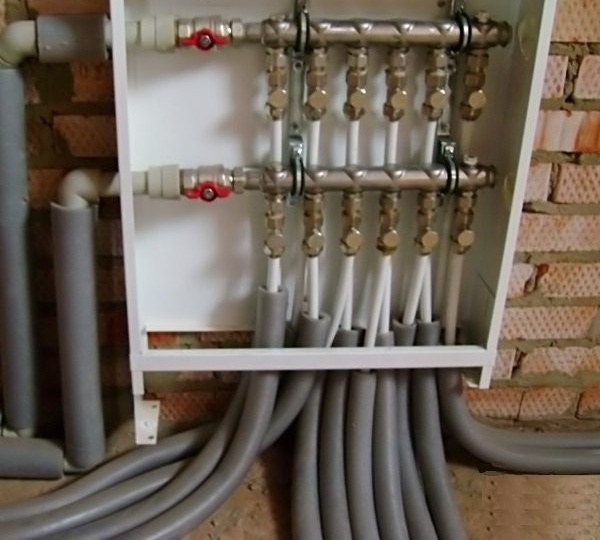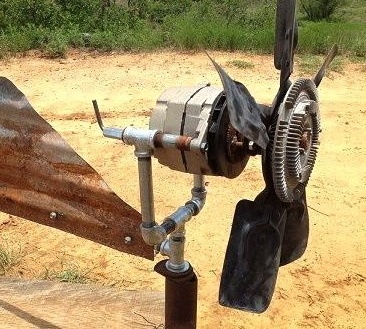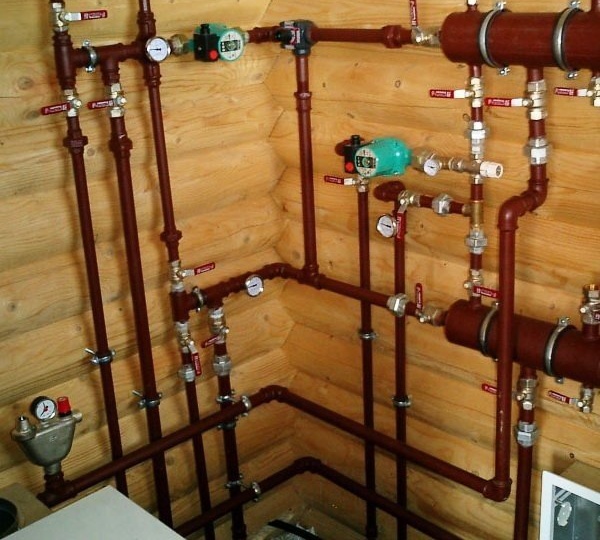Comb for heating system: overview of installation rules + do-it-yourself algorithm
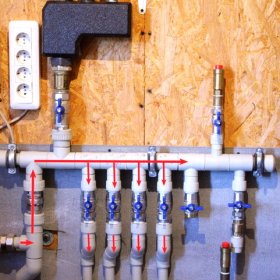
The work of the heating system in a country house should fully satisfy the needs of its owners. But modern requirements for comfort are steadily increasing. In addition to the traditionally necessary hot water supply and heating, both pool heating and underfloor heating are in demand today.
At the same time, piping layout schemes are invariably complicated. How not only to optimize the heating scheme, but also to make it work efficiently, without ruining at the same time on the purchase of fuel? Experts say that to achieve our goals we need a distribution comb for heating.
Content
Why do you need a comb?
What makes up the functionality and efficiency of the heating system? It should provide a comfortable temperature in all areas of the house and the necessary heating of water. In addition, it must be safe during operation and as maintainable as possible.
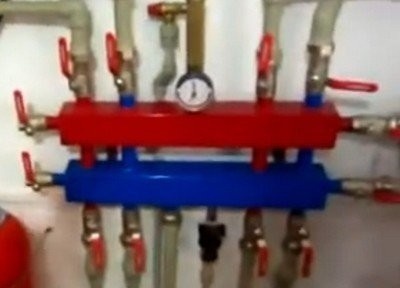
One of the functions of the comb is the ability to turn off the coolant supply to a separate heating system circuit. This allows you to carry out repair work without turning off the heating in general
All these conditions of normal operation help to solve the functional element. collector (beam) heating wiring diagramcalled collector or comb. Suppose, in a house, suddenly, as most often happens, a radiator or pipe joints flowed. If you have a comb, you can solve this local problem without turning off all the heating. Enough, just by shutting off the desired valve, turn off only the area that needs repair.
In addition, one collector, which is installed on the entire heating system of the cottage, perfectly copes with the function of monitoring the heating process. He will be able to adjust the temperature in each room of the house. Using this device allows you to control the heating system quite efficiently and simply. In this case, the costs of manpower and resources are minimized.
An overview of devices designed to adjust the temperature is given in our material:https://aquatech.tomathouse.com/en/otoplenie/radiatory/regulirovka-temperatury.html.
Both the distributor and the regulator
At its core, the distribution comb is a centralized unit that allows the coolant to be distributed to destination points. In the heating system, it performs no less important function than circulation pump or the same boiler. It distributes the heated water along the mains and regulates the temperature.

This diagram shows the general principle of operation of the collector block, consisting of two combs: through one, the coolant is supplied to the system, and through the second it is returned
This node can be called a temporary coolant storage. It can be compared with a barrel filled with water, from which the liquid flows out not through one hole, but through several. In this case, the pressure of water flowing from all openings is the same. This ability to provide at the same time even distribution of the heated liquid is the main principle of the device.
Externally collector It looks like a knot of two combs, made, most often, of stainless steel or ferrous metal. The findings contained in it are intended for connecting heating devices to it. The number of such conclusions should correspond to the number of serviced heating appliances. If the number of these devices increases, the node can be increased, so the device can be considered dimensionless.
In addition to the findings, each comb is equipped with locking mechanisms. It can be two types of cranes installed at the outlet:
- Cutting off. Such cranes can completely stop the supply of coolant from the general system to its individual circuits.
- Adjusting. Using these taps, the volume of water supplied to the circuits can be reduced or increased.
The manifold includes valves for draining water and discharging air. It is also most convenient to place the measuring equipment in the form of heat control meters. In this case, everything that is necessary for the effective operation of this unit will be in one place.
Why does the collector block include two combs? One serves to supply coolant to the circuits, and the second is responsible for collecting already cooled water (return) from the same circuits. All the elements necessary for effective functioning must be on each of the combs.
Collector placement rules
If we are talking about a private house consisting of several floors, collectors are placed on each of them. They will be responsible for the heat supply of rooms located on the floor on which they are installed. This helps to save on fuel. These devices make the contour of each floor autonomous. If there are rooms on one of the floors that are not used during the daytime, their temperature can be temporarily lowered.
However, you can adjust the temperature regime not only on the floor as a whole. Sometimes it’s enough to turn off only one room or even just one radiator. This procedure will not affect the operation of all other heating devices. In addition, the heating of each of the radiators occurs evenly, since it receives the coolant using a separate pipe, which is suitable for it.
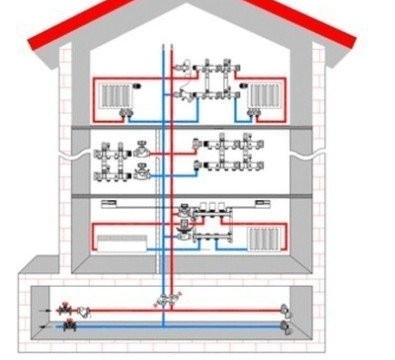
If the heating scheme is drawn up for a multi-story building, you should put your own collector on each floor, then he will be responsible for the operation of heating devices on this particular floor
Such a heat supply system may seem like a rather expensive construction, but during operation, the benefits of its use become apparent. It is self-supporting and the costs incurred at the installation stage will no longer seem excessive to you.
If there is a need for urgent repair of any of the circuits or any particular heating device, then the benefits of using a collector becomes obvious. The repairman will simply disconnect the damaged area or device from the coolant flow by shutting off the tap at the outlet of the switchgear.
Of course, the use of this heating system has not only advantages, but also disadvantages.
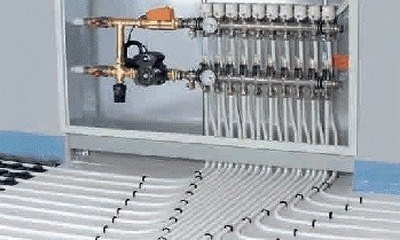
Of course, the pleasure of living in a warm place and having the opportunity to save on fuel and possible repairs is not cheap. But over time, all your initial expenses will pay off
For example:
- Significant costs at the installation stage.Simple pipes are cheaper than steel products of high strength, which is necessary for the manufacture of the collector. This must be taken into account, and then the cost of the locking mechanisms used in the circuit should also be added. With an increase in the number of circuits, costs also increase in direct proportion.
- The need for a circular pump. Such a pump is simply necessary for the operation of the radiation circuit, and this entails an increase in energy costs.
- Additional expenses. If a separate branch will be suitable for each of the heating devices, you will have to spend money on additional pipes and pay for their installation.
The increase in the volume of work will lead to the fact that they can drag on for a long time. But in the process of operation, this system will be more reliable and efficient.
You will learn about choosing suitable pipes for installing a heating system in our next article:https://aquatech.tomathouse.com/en/uchebnik/truby/kakie-truby-dlya-otopleniya-luchshe-vybrat.html.
Rules for mounting the comb
The place to place the collector block must be determined at the design stage of the house. As mentioned above, if it will be a multi-storey cottage, then such nodes should be provided on each floor. It is best to prepare for them special niches that are located above floor level.
However, if you could not find a place for the node in advance, you can install this unit in any room in which it will not interfere with anyone: in the pantry, in the corridor or in the boiler room. If there was no excess moisture in this place.
To prevent the assembly from being visible, you can place it in a special cabinet that manufacturers of locking mechanisms offer their customers. The case of such a cabinet is made of metal. It is equipped with a door, and in its side walls there are openings for heating pipes. Sometimes the collector group is simply placed in a niche or on the wall, fixing the combs with the help of special clamps.
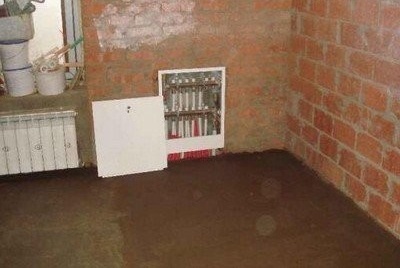
This comb is placed in a specially equipped place for it. As you can see, it looks quite aesthetically pleasing, and most importantly, access to this site will not be difficult
Pipes that extend from this switchgear are placed in walls or in the floor, and then connected to radiators. If the pipes are in the floor screed, the radiators should be equipped with an air vent or air tap.
How to build a collector yourself?
You can buy a ready-made bond, picking one that would approximately meet the needs of your home. But achieving an exact match is quite difficult. Therefore, it is better to do the heating comb with your own hands. Let's figure out what is needed for this.
Planning stage
There are a number of parameters of the heating system of the house that you should know when constructing a block.
- The number of circuits through which the heated water will pass.
- The quantity and technical characteristics of the heating equipment included in the circuit.
- Additional equipment involved in the installation. This includes pressure gauges, thermometers, cranes, storage tanks, valves, pumps, etc.
It is necessary to provide for the possibility of increasing the load, if over time it is necessary to build in elements that are not considered in advance. It can be, for example, solar panels or a heat pump.
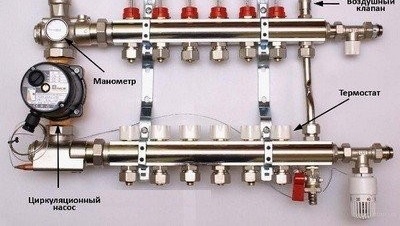
It is necessary to foresee not only the number of circuits operating in the heating system, but also additional equipment that will be included in the general scheme
We determine the design of the block
The design of the future node depends on the connection point of each of the circuits. After all, there are some nuances of connection, which cannot be ignored.
- Boilers (electric and gas) must be connected to the comb from above or below.
- The circulation pump should be connected from the end of the structure.
- Solid fuel aggregates and indirect heating boilers also need to be cut from the end.
- The heating system supply circuits are connected from below or from above.
For clarity, it is necessary to make a drawing of a future compact and neat assembly. This will help determine the quantity and types of materials that we will need. All necessary dimensions, threaded connections with a thread pitch are also applied to the drawing. All circuits should be marked to follow the drawing when connected.
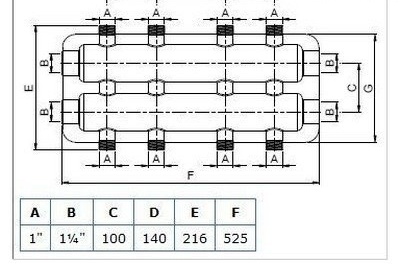
This drawing shows a four-way manifold. You can not make a drawing and limit yourself to a sketch, but do not forget to put on it all the dimensions necessary for work
The distance between the nozzles of both combs should be from 10 to 20 cm. These are optimal parameters for maintenance. The distance between the feed and return combs themselves should also be within the same limits.
Work sequence
For the manufacture of both combs can be used not only round, but also square pipes. The sequence of work is as follows:
- In full accordance with the parameters indicated on the drawing, we acquire all the necessary materials.
- According to the drawing, we make the connection by welding pipes taking into account their subsequent functions. Welding spots should be brushed with a metal brush and degreased.
- Testing a homemade unit is a necessary stage of work. To do this, all the nozzles are hermetically closed except one, through which hot water is poured into the system. We will carefully examine all the joints: they should not leak.
- Now the collector can be painted and thoroughly dried.
- Next, you should connect pipes, locking mechanisms and control equipment to it.
After that, the device is ready for operation. This will be favorably distinguished from purchased products in that it is built taking into account the needs of a particular house, and this is very important for its further operation. Of course, a high-quality and functional device can be obtained only if the master is able to handle the welding machine and the bench tool.
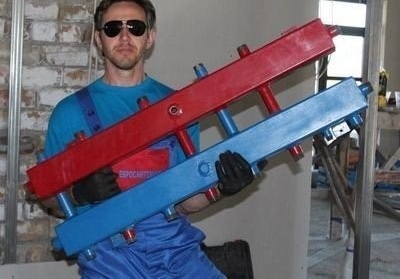
In order for the home-made collector block to work more efficiently than the purchased one, the craftsman needs to be able to handle both welding equipment and locksmith tools
You can find out how to make a collector from polypropylene by watching this video:
